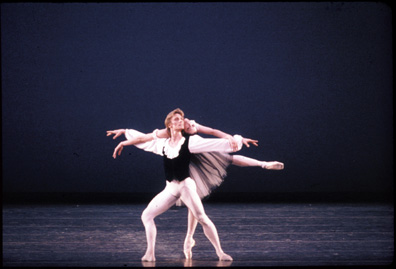The Race is Not to the Swift
"Mozartiana",
"Le Spectre de la Rose", "Swan Lake act III pas de deux",
"Le Corsaire pas de deux", and "Sinfonietta"
American Ballet Theatre
City Center
New York, New York
Sunday, November 7, 2004, matinee
by Mary Cargill
copyright
© 2004 by Mary Cargill

The Black Swan pas de deux, danced by Paloma Herrera and Marcelo Gomes, was somewhat understated dramatically. In part, I expect this is because Petipa's choreography is so dramatically integrated into the story that it lacks focus out of context. Paloma Herrera, too, just doesn't project a character; her upper body had no snap or sparkle, and she seemed to be marking time until she could balance and turn, which of course she does to a farethewell. But the supported pirouettes, as is often the case at ABT nowadays, were ground out for extra and somewhat effortful turns, rather as if the ballerina were an exotic can opener.
"Le Corsaire pas de deux", with Angel Corella and Gillian Murphy, worked much better, perhaps because it was choreographed as a dance interlude, a generalized homage to female beauty and masculine power rather than as a part of a coherent drama. Gillian Murphy, who can also turn like a ball bearing—she threw in a number of triples—danced the choreography (as opposed to barreling through it) with an expansive majesty and creamy grandeur in her upper body, finishing each phrase; it was a very nuanced and beautifully modulated performance. Mr. Corella seemed to be making the steps up as he went along, turning, bending, jumping at the same time. But he kept the feathery, exotic style in his upper body which kept his dancing from turning into an anonymous, athletic blob.
"Sinfonietta", popular and well-populated though it is with outstanding dancers, remains a bit of a blob, one anonymous dancer after another doing the same steps in seemingly endless repetition. David Hallberg and Marcelo Gomes, for a brief soaring moment as they jumped together, managed to seem like they were going somewhere, and Monique Meunier danced with a luscious conviction.
But for all the excitement, the most satisfying performances came in Balanchine's serene and gentle "Mozartiana", danced by Veronika Part and Maxim Beloserkovsky (he seems to have dropped the "t" from his last name). The Russian soul may be an exaggeration, but the eloquent combination of the Russian composer, choreographer, and dancers did seem to fit. Ms. Part is an extraordinarily beautiful woman in a time when real grown up women seem scarce. She dances with a luxurious ease and richness, and the hushed moment of silence after the Preghiera said more about the power of dance than all the lusty cheers that greeted the later fouttéefests. Mr. Beloserkovsky compliments her very well in this work; he has the unusual combination of sprightliness and elegance that the role needs. Unlike so many Balanchine pas de deux, the partnership in "Mozartiana" is not a romantic one, it seems to be a conversation between two opposites, between the moon and the sun. Ms. Part, even when she is playful, seems to have a hint of melancholy, as if she is visiting briefly and knows she must return somewhere out of reach. Unlike the whiz bang technicians, which she certainly is not (her feet aren't terribly strong and she isn't a speed demon), I remember her for what she seems to be, rather than what she does, which is another way of saying that for me she is a pure artist, and watching her is one of the most wonderful gifts ABT has given New York.
Photo: Veronika Part and Maxim Beloserkovsy in Mozartiana. Photo: MIRA.
Volume
2, No. 42
November 8, 2004
Copyright
©2004 by Mary Cargill
|
|
|